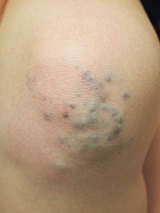What are glomuvenous malformations?

Also called glomus cell tumors and glomangiomas, glomuvenous malformations are clusters of bluish blood vessels in the skin and superficial fat. They contain specialized blood cells known as glomus bodies. Glomus bodies are a normal part of the skin circulation that help regulate body temperature by constricting blood flow to the skin to preserve body heat or relaxing to increase skin circulation to release body heat. Abnormal clusters of these bluish-purple nodules are often painful and sensitive to pressure. If they occur under the fingernails, they can be extremely sensitive to touch.
Glomuvenous malformations are benign but can be annoying, and patients may develop clusters in any part of the body. They can occur in members of the same family, demonstrating a strong inheritance pattern.
What are the treatment options?
Laser treatment is not usually effective in the treatment of glomuvenous malformations because of the depth of involvement in the skin, and surgical excision is usually recommended for symptomatic lesions. Injection with a weak alcohol solution (sclerotherapy) may also be helpful, although multiple injection sessions may be necessary for best results, making treatment tedious and sometimes uncomfortable. The Comprehensive Vascular Anomalies Program (CVAP) at Children's Hospital of Philadelphia (CHOP) will create an individualized treatment plan for each patient.
The CHOP difference
Children seen by the CVAP team at CHOP benefit from a multidisciplinary team with extensive experience and deep expertise in the assessment and management of glomuvenous malformations. World-class specialists offer comprehensive care tailored to each child’s condition. The CVAP team at CHOP supports patients and their families every step of the way in their journey in managing a diagnosis of glomuvenous malformations.
Resources to help
Comprehensive Vascular Anomalies Program (CVAP) Resources
Reviewed by Michael D. Fox, MD, MEd, David W. Low, MD
